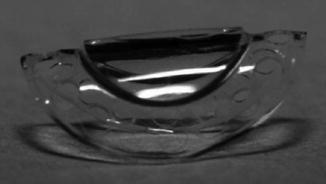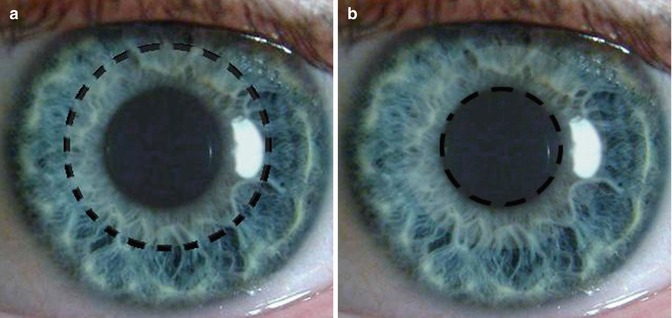Incision size (mm)
Number of sutures
Donor cornea needed
Single- or two-stage surgery
KeraKleara
3.5 mm diameter
0–4
No
Single
Boston KPro
8.0 mm diameter
16–24
Yes
Single
AlphaCor
19.0 mm circumferential
10–12
No
Twob
As a result, it was highly desirable to develop a keratoprosthetic device that would neither require staged procedures nor a donor corneal carrier. To address these limitations, a new foldable artificial cornea was developed: the KeraKlear keratoprosthesis (K3) from KeraMed Inc. (Sunnyvale, California).
This chapter describes this novel device and reviews its current status, indications, and use. At the time of publication, KeraKlear KPro has received CE mark approval in Europe but has not yet been approved by the US Food and Drug Administration (FDA) for use in the United States [3].
23.2 KeraKlear KPro (K3): Description and Overview
KeraKlear KPro (K3) is a foldable and injectable single-piece artificial cornea with no back plate or locking ring. It is made of clear flexible and strong proprietary biocompatible acrylic material, similar to what is used in intraocular lenses (Figs. 23.1 and 23.2). This keratoprosthesis is designed to be implanted into an intracorneal stromal pocket by femtosecond laser, forming a clear window in an opacified cornea. It requires a single-stage procedure without the need for a carrier cornea.



Fig. 23.1
Front profile of the KeraKlear keratoprosthesis demonstrating the 18-hole peripheral design with 4.0 mm central optic

Fig. 23.2
Proprietary acrylic material allows KeraKlear to be folded or injected for insertion
The KeraKlear KPro is 7.0 mm in diameter with a 4.0-mm central optic and 18 peripheral holes to facilitate fixation, hydration, and nutrition of the remaining cornea. It is available in two versions: the phakic/pseudophakic version of 44 diopters (D) and the aphakic version of 60 D.
Due to its physical properties, KeraKlear KPro can be folded or injected through a micro-incision of 3.5 mm into an 8 mm corneal pocket, created manually or by a femtosecond laser.
KeraKlear KPro has been designed for use in partial-thickness techniques. In partial thickness, or anterior lamellar technique, the KeraKlear KPro requires removal of a small portion of the anterior corneal tissue in order to be implanted (Vargas JM, Shiuey Y, A foldable artificial cornea for treatment of cornea blindness, personal communication at ASCRS, 2012). The artificial cornea is secured into the corneal stroma by passing 10-0 nylon sutures through the peripheral holes. Over time, the stroma will grow through the holes to provide permanent fixation (Fig. 23.3).


Fig. 23.3
Image demonstrating the benefit of the KeraKlear over penetrating keratoplasty. (a) Corneal transplant (PKP) 8 mm diameter full-thickness incision. (b) KeraKlear artificial cornea 3.5 mm diameter. The KeraKlear can also be implanted as an artificial lamellar graft
Surgery can be conducted under either local anesthesia (peribulbar or retrobulbar injection) or general anesthesia.
23.3 Surgical Procedure
23.3.1 KeraKlear KPro Packaging
The KeraKlear artificial cornea is individually packaged in a saline-containing glass vial, enclosed in a pouch, and steam sterilized. The pouch and vial may only be opened in a sterile environment. A patient identification card and a set of labels are provided.
To remove the KeraKlear KPro, the protective sealed box is opened and the pouch containing the glass vial, with the KeraKlear KPro, is taken out. Beginning at the chevron end of the sterile pouch, a tear is made to release the glass vial onto a sterile table. The glass vial screw cap is opened, and the gray stopper is removed. Contents of the vial are transferred into a sterile dish; the KeraKlear artificial cornea is gently retrieved with forceps. The artificial cornea should be examined under the microscope for any damage and then rinsed with sterile saline solution.
Stay updated, free articles. Join our Telegram channel

Full access? Get Clinical Tree


